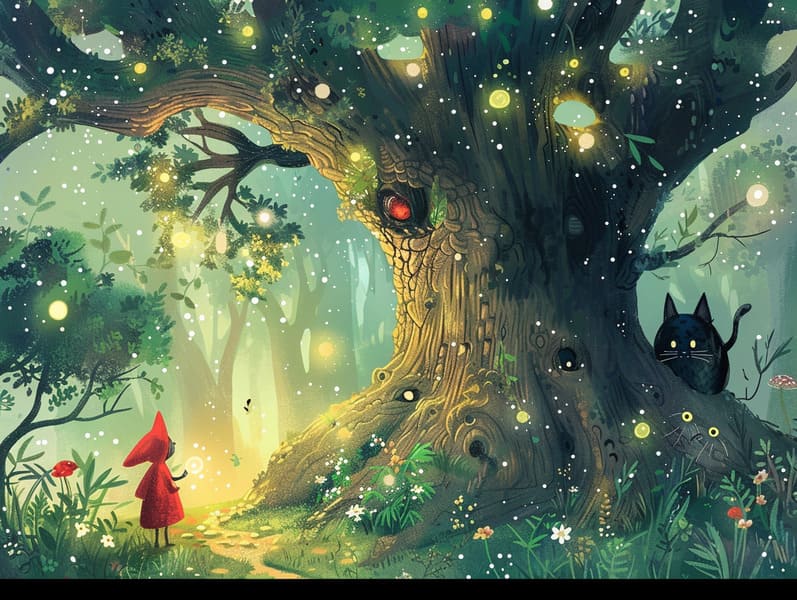A Brief History of Children's Fairy Tales with Its Continued Allure.
A Brief History of Children's Fairy Tales with Its Continued Allure.
Blog Article

Legendary fairy tales have old origins. These narratives have been told from one generation to the next long before they were ever transcribed. They developed from a variety of cultures, including Indigenous traditions. They were initially narrated among older generations, often carrying themes and messages relevant to the societal norms and beliefs of the time.
The famous Grimm duo, Jacob and Wilhelm, were among the first to assemble many of these beloved narratives. Their anthology, "Grimm's Story Collection," included tales like "The Little Glass Slipper," "The Story of Hansel and Gretel," and "Snow-White and Rose-Red," which have since become essentials in the world of famous fairy tales. Similarly, Andersen's fantastical stories, such as "The Story of the Little Mermaid," and "The Duckling's Story," have touched hearts worldwide, cementing their place in the pantheon of timeless fairy tales.
Though they are centuries old, traditional fairy tales remain as pertinent as ever, especially as children's night stories. These enchanting tales are now available in different formats, including colorful picture books, fantastical animations, and digital storybooks.
Their enduring popularity can be ascribed to several delightful features:
Crucial Morals: Traditional fairy tales often share important moral lessons. Narratives like "The Shepherd Boy and the Wolf" teach the importance of honesty, while "The Hare and the Tortoise" illustrate the virtues of resolve and humility. These tales offer kids clear distinctions between correct and incorrect, developing their moral compass in a kind yet important way.
Sympathy and Perception: Ancient fairy tales frequently feature personalities facing problems and hurdles, encouraging readers to sympathize with their struggles and support their triumphs. For instance, "Beauty and Her Beast" illustrates the necessity of looking deeper to acknowledge the real person of a individual, encouraging understanding and comprehension.
Cultural Understanding: Many old fairy tales are steeped in the cultural contexts from which they bloomed. Delving into these stories can provide illuminating insights into different societies, nurturing a sense of cultural awareness and discernment.
Fantasy and Imagination: The fantastical elements in old fairy tales—supernatural elements—awaken children’s inventiveness. These stories guide readers to fantastical realms, promoting inventive dreams and a sense of curiosity that remains a lifetime.
Timeless fairy tales are not only charming but also instructive. They act as fascinating tools in fostering various brain and heart skills in young readers. When old fairy tales are recited, they enhance verbal skills by bringing new language items and sophisticated sentence structures. This practice also promotes auditory skills and mental focus, as young readers hang on every word, eager to see what happens next.
Furthermore, discussing the themes and characters of timeless fairy tales can advance reasoning skills and evaluative skills. Kids are taught to recognize patterns, anticipate outcomes, and grasp cause and effect. These debates also further young ones express their thoughts and feelings, adding to their emotional intelligence.
In today’s digital era, the existence of internet fairy tales has made these stories more reachable than ever. Internet resources and apps provide broad selections of ancient fairy tales that can be looked at or listened to anytime, anywhere. Fairy tales told out loud are particularly well-received, offering an fascinating method for the awesome site young to experience these fantastical tales. Voice books and read-aloud videos guide characters and settings to life, often paired with mesmerizing soundtracks and harmonies that improve the tale-telling adventure.
The unfading fascination of ancient fairy tales lies in their ability to evolve to today's world while holding onto their key morals. Contemporary reimaginings of these fairy tales often bring in more representative protagonists and modern settings, making them relatable to today’s audience. However, the core values of gallantry, humanity, and righteousness remain unchanged, continuing to affect listeners of all ages.
Old fairy tales also offer a sense of comfort and knowability. They afford a ordered narrative with a unmistakable beginning, middle, and end, often closing with the termination of conflicts and the triumph of virtue over wickedness. This foreseeability can be calming for young ones, proffering a sense of solidity in an unpredictable world.
Traditional fairy tales continue to enchant and instruct new generations, maintaining their wonder and meaningfulness in modern society. As children's night stories, they make accessible a perfect blend of allure and teaching, backing moral values, empathy, and creativity. The existence of web-based fairy tales and the well-liked nature of fairy tales read aloud confirm that these old stories remain within reach to new generations.
By retaining and telling these stories, we continue to extol the rich tapestry of tales and cultural heritage. Whether you are experiencing a richly illustrated book, viewing a web-based library, or listening to an sound book, the magic of timeless fairy tales is always within reach. These tales teach us of the steadfast essence of fairy tales and its ability to link us across generations and cultures.
Regardless if you are reading a beautifully illustrated book, viewing a virtual collection, or listening via an read-aloud book, the spell of children's fairy tales is always within reach.
These tales teach us of the steadfast essence of tales and its ability to unify us across centuries and lands, creating a bond that delights and instructs alike.